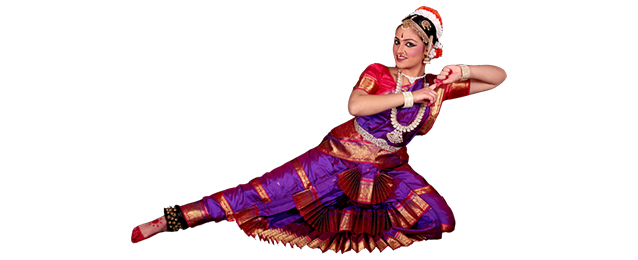Bharatanatyam

Overview
Bharatanatyam or Bharathanatiyam (Tamil: பரதநாட்டியம்) is a major genre of Indian classical dance that originated in the Hindu temples of Tamil Nadu and neighboring regions. Traditionally, Bharatanatyam has been a solo dance that was performed exclusively by women, and expressed Hindu religious themes and spiritual ideas, particularly of Shaivism, but also of Vaishnavism and Shaktism.
Categories
Alarippu: The presentation begins with a rhythmic invocation (vandana) called the Alaripu. It is a pure dance, which combines a thank you and benediction for blessings from the gods and goddesses, the guru and the gathered performance team. It also serves as a prelim warm up dance, without melody, to enable to dancer to loosen her body, journey away from distractions and towards single-minded focus.
Jatiswaram: The next stage of the performance adds melody to the movement of Alarippu, and this is called Jatiswaram. The dance remains a prelim technical performance (nritta), pure in form and without any expressed words. The drums set the beat, of any Carnatic music raga (melody). She performs a sequence (Korvai) to the rhythm of the beat, presenting to the audience the unity of music, rhythm and movements.
Shabdam: The performance sequence then adds Shabdam (expressed words). The solo dancer, the vocalist(s) and the musical team, in this stage of the production, present short compositions, with words and meaning, in a spectrum of moods.
Varnam: The performance thereafter evolves into the Varnam stage. This marks the arrival into the sanctum sanctorum core of the performance.[59] It is the longest section and the nritya. She presents the play or the main composition, reveling in all her movements, silently communicating the text through codified gestures and footwork, harmoniously with the music, rhythmically punctuated. The dancer performs complicated moves, such as expressing a verse at two speeds. Her hands and body tell a story, whether of love and longing, or of a battle between the good and the evil, as the musicians envelop her with musical notes and tones that set the appropriate mood.
Padam: The Padam follows next in the sequence of the performance. This is the stage of reverence, of simplicity, of abhinaya (expression) of the solemn spiritual message or devotional religious prayer (bhakti). The music is lighter, the chant intimate, the dance emotional. The choreography attempts to express rasa (emotional taste) and a mood, while the recital may include items such as a keertanam (expressing devotion), a javali (expressing divine love) or something else.
Thillana: The performance sequence ends with a Tillana, the climax. It closes out the nritya portion, the movements exit the temple of expressive dance, returning to the nritta style, where a series of pure movement and music are rhythmically performed. Therewith the performance ends.

